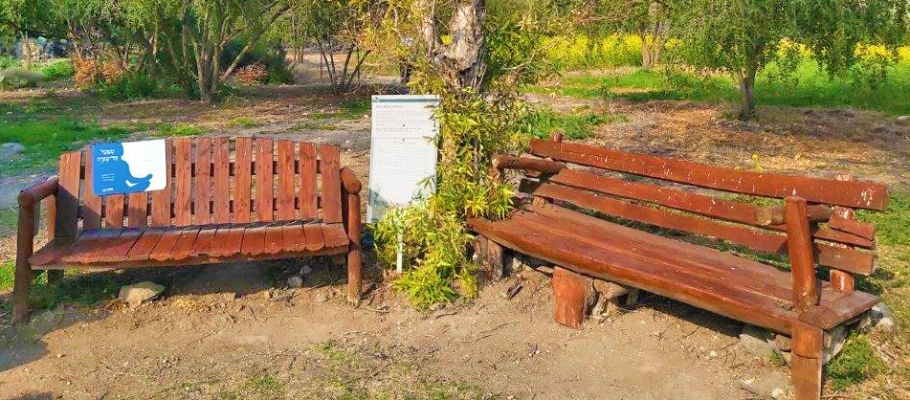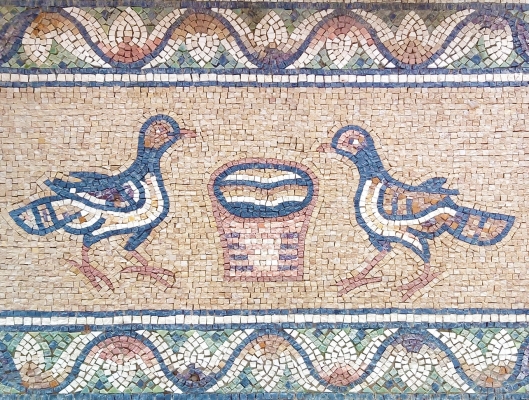Kursi National Park, Israel
Text & Photos: Lydia Aisenberg
There are not many places in Israel where one can find the impressive remains of a large Byzantine church full of colorful mosaic floors, an ancient olive press and a marble lined Roman Bath – all just a short walk away from the wreck of a turretless "blast from the past" German-manufactured Panzer 4 tank, once owned by the Syrian Army.
The Byzantine church was discovered in the late 1960s, during road construction in the eastern portion of Lake Kinneret, and the Panzer 4 was uncovered only in recent years with the further development of a nearby national park. The Second World War German tank had been totally obscured by a dense thicket and mass of undergrowth, out of sight and out of mind for many decades.
A couple of dark wooden benches are situated on a small incline under some eucalyptus trees, close to the church, and on the other side of the remains of the World War II rusting armored relic – at the time of writing, surrounded by a glorious field of springtime bright yellow wild flowers.
According to a large sign in Hebrew and English, the benches are on a patch of ground that gives forth a high and calming energy. When checked by scientists, it was found indeed that the energy level there was far higher than the norm.
A sign attached to one of the benches explains the uplifting phenomenon, although this writer had some difficulty in understanding about the bobis – a term used by Polish grandparents in her childhood that usually referred to made up stories, or in plainer non-Polish Yiddish English, fibs!
The intriguing bench sign reads:
"The Energy Bench: under the old eucalyptus trees there are two benches. Their location is in a high energy area, as when scientists measured the energy level at this site they found that the level was higher than normal at 8 million bobis (bobis=unit of vitality=energy)! In our house, healthy and energetic as it may be, there are 40 thousand bobis, so, come on, hurry up and be recharged with good energies that are in the benches area – choose some yoga exercises, breathe deeply and charge yourself!
And … don't forget to take a picture and tag the site on social network media."
The church, tank and benches, complete with a bundle of high energy, can be found at the Kursi National Park, a relatively small but very attractive site that is tucked away, perched on a narrow strip of land a few kilometers from the harbor and kibbutz of Ein Gev, running along the eastern shore of Lake Kinneret and situated some 700 meters below sea level.
The ancient site, discovered quite by accident, was excavated by archaeologists from the Israel Department of Antiquities and Museums, and was identified as the ancient Kursi, mentioned in the Talmud as a center of idol worship. Over time as the dig expanded, the largest known Byzantine monastery in the land was discovered.
The Roman Bath excavated at Kursi proved to be a unique structure in Israel, having been built so near a monastery in that era. During excavations carried out some 20 years ago, various coins and medallions were unearthed from the rooms of the bath house that shed light on the historical significance of the site.
Until the war of 1967, Kibbutz Ein Gev sat directly under the heavily fortified bunker positions of the Syrian Army, along the ominous Golan Heights. For many years Israeli fisherman, plying their trade along that eastern shoreline, often came under fire from the Syrians entrenched in strongholds looming over both the eastern shores and a section of the northern shores of the lake.
Attacks on Israeli fishermen were often directed to an area along the east bank, where an important water source, Nachal Somekh, flows down from the Golan and enters the Kinneret, to this day creating a rich breeding ground for fish.
The fishermen and kibbutz farmers working the communal fields and the extensive banana plantations – the latter tucked tightly between the shore and the Israel-Syrian border running along the base of the mountains – were in constant danger of being fired upon at as they carried out their daily chores. Their tractors were cumbersome to operate as they were covered in weighty armored plating for protection.
With the Syrian soldiers firmly ensconced close to the Kinneret shoreline at Kursi, making constant attempts to divert water away from the Kinneret – the main freshwater source in Israel – the Israel Defense Forces launched an operation on December 11, 1955, against the Syrian base at Kursi. It was known as Operation Olive Leaves, sometimes also referred to as Operation Kinneret.
Under the command of Meir Har-Zion, the IDF's Paratroop Brigade reconnaissance company was tasked with the attack on Kursi, setting out from Ein Gev in small squads with the intention of attacking the Syrian stronghold at a certain hour simultaneously from different points.
However, a bullet discharged accidently by one of the Israeli soldiers meant that the attack was brought forward and the Syrians – although forewarned by the rogue bullet – were taken by surprise. They sustained heavy losses, and the battle was over within a few hours.
The following day (December 12, 1955) Maariv, stated that 4 Israeli soldiers were killed and 12 injured, with Syrian Army losses in the battle standing at 50 killed and 30 taken prisoner by the Israeli forces.
So, how did the Panzer 4 turretless tank – hidden in the undergrowth end up so close to the nowadays busy road, at a point just before the turn off climbing up the steep, zigzagging road to the post-1967 Jewish communities of Givat Yoav and Afiq in the Golan Heights?
A large blue metal sign of the Society for Preservation of Israel Historical Sites, erected in the vicinity of the tank, fills in the blanks. It explains that at the beginning of the 1950s, the Syrians bought from France, Spain and Czechoslovakia scores of KROP manufactured Panzer 4 tanks that were left over from World War II. Former German Wehrmacht officers were brought to Syria to teach the Syrian soldiers how to use and maintain the Panzers.
Many of the Panzer 4s were placed in dug-out emplacements along the Golan. They posed a serious threat to Israeli Forces during the late 1950s and up until 1967. These clashes were known as the "water wars," that period during which the Syrians constantly attempted to syphon off water from sources filling the Kinneret freshwater lake which is so vital to Israel.
MARCH, 2025









Comments